Three Kingdoms Period of China: Epic Era Full of Legends (220 – 280 CE)
The Three Kingdoms Period (三国, Sān Guó, 220-280 CE) was a pivotal chapter in Chinese history known for its intense power struggles, military campaigns, and profound cultural developments. Spanning about six decades, this era witnessed the disintegration of the Eastern Han Dynasty and the emergence of three distinct kingdoms: Wei (魏), Shu (蜀), and Wu (吴).
The Three Kingdoms Period stands as a testament to the resilience, cunning, and ambition of its prominent warlords and has left an indelible mark on Chinese civilization.
The Beginning
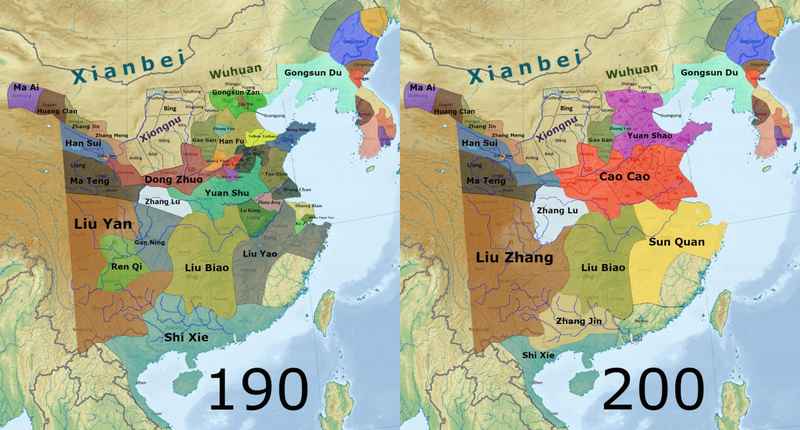
Maps of territories in 190 and 200 CE before the establishment of the three kingdoms
The Three Kingdoms' tripartite confrontation emerged in the late Eastern Han Dynasty, but there are different opinions regarding the exact starting time of the Three Kingdoms Period.
In a broad sense, the formation of the Three Kingdoms initially began with the Yellow Turban Rebellion (黄巾起义) in 184 CE. At that time, the Eastern Han court was influenced by years of corruption and turmoil caused by eunuchs and powerful families, leading to intense social conflicts. The rebellion erupted among the common people, quickly escalating into widespread warfare across the country.
In order to suppress the uprising, the central government had local authorities recruit armies for assistance. Although the Yellow Turban Rebellion was successfully quelled, it resulted in local governments becoming increasingly independent while the central government gradually lost control. This eventually led to the formation of warlord factions and the subsequent emergence of the tripartite confrontation of the Three Kingdoms.
However, in a narrower sense, it wasn't until 220 CE when Cao Pi (曹丕) forced Emperor Xian of Han (汉献帝) to abdicate, establishing the Cao Wei Dynasty (曹魏) in the northern part of China and marking the end of the Eastern Han Dynasty, that China's history officially entered the Three Kingdoms period.
The Three Kingdoms
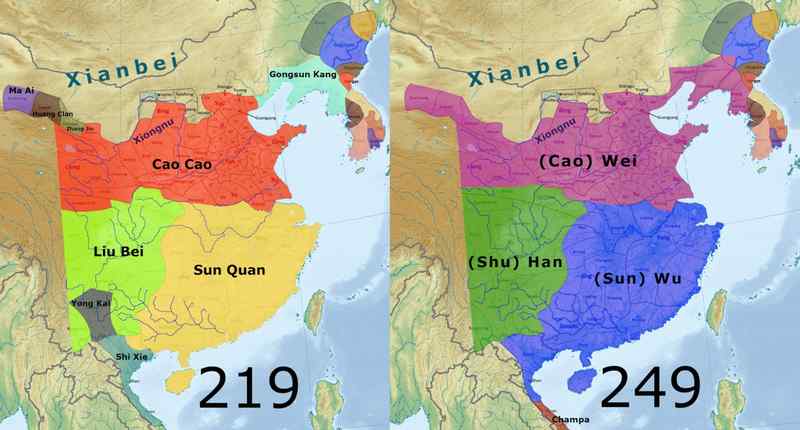
Left: map of territories in 219 CE right before Wei's establishment. Right: map of the three kingdoms in 249 CE.
The three major powers of Wei (魏), Shu (蜀), and Wu (吴) during this era of legends were established by ambitious warlords who sought to seize power and reunify the fragmented land. Each kingdom had its own unique characteristics, leaders, and strategies, which contributed to the intense and dynamic nature of the legendary era.
Wei or Cao Wei, 魏/曹魏 (220-266 CE)

Left: map of territories in 220 CE right after Wei's establishment. Right: map in 266 CE right after Wei's end.
The Kingdom of Wei (魏), founded by Cao Cao (曹操), initially emerged as the dominant force in northern China.
Cao Cao, a shrewd and capable strategist, took advantage of the weakening central authority of the Han to establish his own power base. He centralized his control over the northern region and commanded a formidable army.
Under Cao Cao's leadership, Wei expanded its territory through a series of military campaigns, defeating rival warlords and consolidating its power. Cao Cao's military success and political acumen enabled him to influence the imperial court and position himself as a prominent figure in the struggle for supremacy.
The Rise
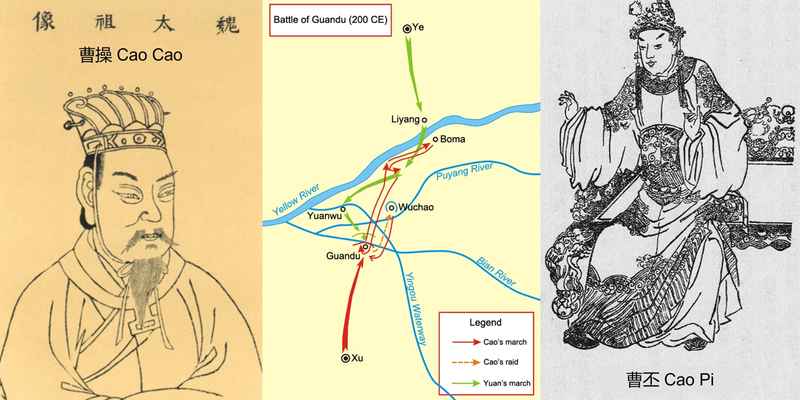
Portraits of Cao Cao and Cao Pi, and the Battle of Guandu
Cao Cao was born into a prestigious family, with his father attaining the position of Grand Commandant (太尉) during the reign of Emperor Ling of Han (汉灵帝). After the disintegration of the coalition forces in the east (关东联军) against Dong Zhuo (董卓) towards the end of the Han Dynasty, Cao Cao embarked on military campaigns, gradually strengthening his power.
In 196 CE, Cao Cao relocated Emperor Xian of Han (汉献帝) to Xuchang (许昌), leveraging the political advantage of "holding the emperor hostage to command the warlords" (挟天子以令诸侯). Under the guise of imperial authority, he launched campaigns against various regional warlords. After years of fierce fighting, Cao Cao gradually expanded his influence and gained control over a significant portion of the Central Plains region (中原).
In 200 CE, during the Battle of Guandu (官渡之战), Cao Cao accepted Xu You's (许攸) suggestion and led his troops to set fire to Yuan Shao's (袁绍) food supplies. Despite being outnumbered, Cao Cao achieved victory, defeating Yuan Shao's powerful separatist forces north of the Yellow River (黄河). This battle also became one of the three most famous battles of the Three Kingdoms period.
Cao Cao successively eliminated the remnants of the Yuan clan's forces, pacified the Liaodong region (辽东), and ultimately unified the north.
The Establishment and Reign
After Cao Cao's death in 220 CE, his son, Cao Pi (曹丕), usurped the Han throne and declared himself Emperor of Wei (魏, also known as Cao Wei, 曹魏), officially ending the Han Dynasty. Cao Wei was established with its capital in Luoyang (洛阳).
Since its establishment, Wei continued to dominate the north, with subsequent rulers focusing on consolidating power and strengthening their governance.
During its reign, Cao Wei held control over the Central Plains and northern regions and possessed far greater national strength compared to the other two states: Shu Han (蜀汉) and Sun Wu (孙吴).
Starting from Cao Cao's unification of the northern region and the implementation of the system of military farming and rent reduction, social stability in the north under the control of Wei gradually improved, and productivity began to recover.
The government repaired roads, constructed water conservancy projects, and facilitated transportation and irrigation. The revived iron industry promoted the widespread use of water-powered mechanisms, and the silk industry flourished.
There was also a gradual improvement in commodity exchange, and during the reign of Emperor Ming of Wei (魏明帝), a new currency was issued. The major cities like Luoyang (洛阳) and Yecheng (邺城) all became increasingly prosperous.
Wei also had significant political reforms, including Chen Qun's (陈群) Nine-Rank System (九品中正制), which had a profound impact on the politics of the following dynasties.
In terms of territory, Cao Wei inherited control over the Western Regions (西域) from the Eastern Han. After the conquest of Goguryeo (高句丽), Wei incorporated the northern part of the Korean Peninsula into its territory, and its southern regions were roughly delimited by the Qinling Mountains (秦岭) and the Huai River (淮河) as the boundaries with Shu and Wu.
The rule of Cao Wei lasted until 266 CE when Sima Yan (司马炎) usurped the throne, and renamed the state Jin (晋), establishing the Western Jin Dynasty (西晋), marking the end of the Cao Wei regime.
Shu or Shu Han, 蜀/蜀汉 (221-263 CE)
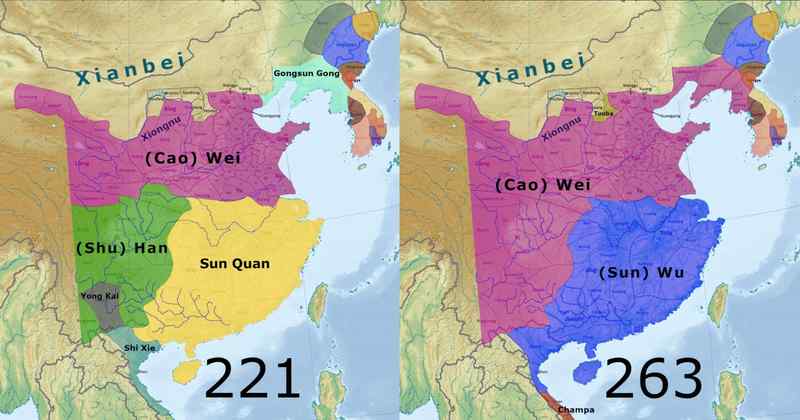
Left: map of territories in 221 CE right after Shu's establishment. Right: map in 263 CE right after Shu's end.
The kingdom of Shu (蜀), led by Liu Bei (刘备), arose in the southwestern region of China, centered primarily in the present-day province of Sichuan (四川).
Liu Bei, bearing the royal name of the Han, was often regarded as a virtuous and charismatic leader, who espoused the principles of benevolent rule and the restoration of the Han Dynasty. He garnered support from the populace by championing Confucian values and seeking the support of the local gentry.
With the assistance of his talented advisor Zhuge Liang (诸葛亮), Liu Bei built a competent administration and military force. The Shu Kingdom engaged in numerous military campaigns, seeking to expand its territory and challenge the dominance of Wei in the north.
The Rise
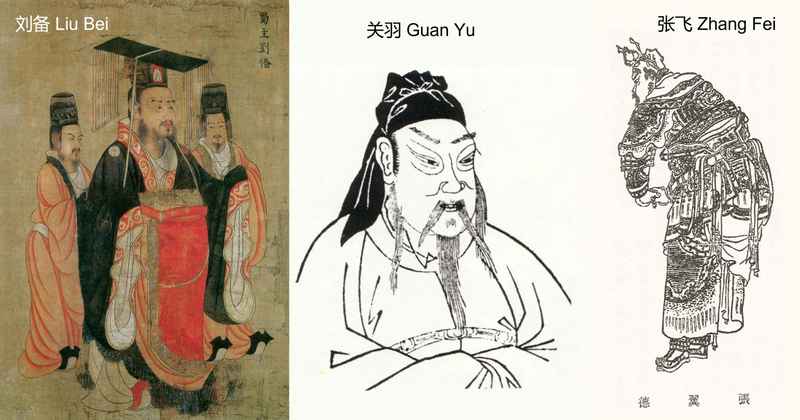
Portratis of Liu Bei, Guan Yu, and Zhang Fei
In the beginning, Liu Bei's military strength was weak. In 208 CE, after three visits to the thatched cottage (三顾茅庐, sān gù máo lú), Liu Bei obtained the assistance of the brilliant strategist Zhuge Liang (诸葛亮), who proposed the strategic concept known as the "Longzhong Plan" (隆中对), which provided insights on the current situation, where Liu Bei stood and strategies of how he can become a dominant force.
With the efforts of Zhuge Liang, Liu Bei formed an alliance with Sun Quan (孙权) and achieved a significant victory over Cao Cao in the Battle of Red Cliffs (赤壁之战). Zhou Yu (周瑜), a general under Sun Quan, used a plan of fire attack and Cao Cao suffered a decisive defeat. The combined forces of Sun Quan and Liu Bei triumphed against superior numbers, forcing Cao Cao to retreat to the north.
The Battle of Red Cliffs became another famous battle in the Three Kingdoms period, following the Battle of Guandu.
From 209 to 219 CE, Liu Bei, with notable generals such as Guan Yu (关羽), Zhang Fei (张飞), Zhao Yun (赵云), Liu Feng (刘封), and Huang Zhong (黄忠), and aided by strategists Zhuge Liang, Pang Tong (庞统), and Fa Zheng (法正), achieved numerous victories and significantly increased their strength.
In 221 CE, after Cao Pi (曹丕) usurped the Han throne and established the Wei Dynasty, Liu Bei declared himself emperor in Chengdu (成都), establishing the state known as Shu or Shu Han (蜀/蜀汉).
The Decline
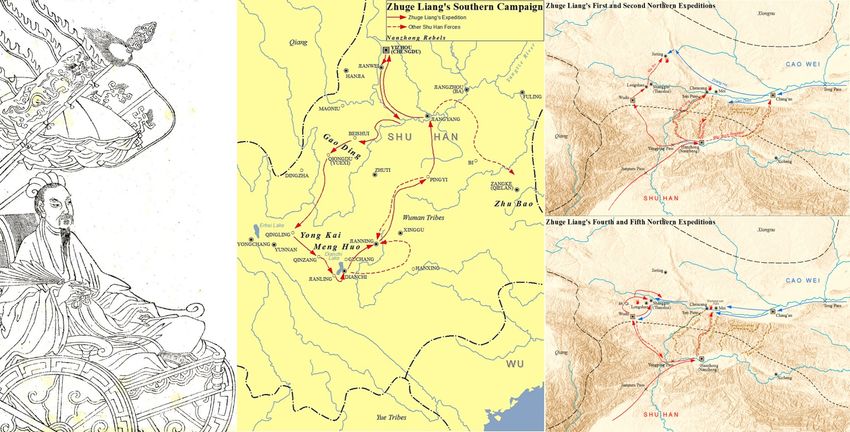
Left: a depiction of Zhuge Liang. Middle: Zhuge Liang's Southern Campaign.
Right: Zhuge Liang's northern expeditions against Cao Wei.
Shortly after proclaiming himself emperor, Liu Bei led a large army, seeking revenge against Sun Quan for seizing Jingzhou (荆州) and the death of Guan Yu.
In 222 CE, Zhang Fei was killed, and Liu Bei's forces confronted Wu's (吴) troops at Yiling (夷陵). In the Battle of Yiling (夷陵之战), also known as the Battle of Xiaoting (猇亭之战), Liu Bei was defeated by Wu general Lu Xun (陆逊). Liu then retreated to Yi Zhou (益州) but soon passed away in Baidi City (白帝城).
The Battle of Yiling marked the last battle among the three famous battles during the Three Kingdoms period. As a result, Shu Han suffered a significant loss of strength, becoming the weakest among the three kingdoms.
Thereafter, however, with the efforts of Zhuge Liang and Sun Quan, Shu Han and Sun Wu (孙吴) restored their alliance and joined forces against Cao Wei (曹魏).
After Liu Bei's death, his son Liu Shan (刘禅) succeeded him, and despite the assistance of Zhuge Liang, Shu Han faced numerous challenges. Liu Shan was later known as the "helpless Liu Adou (his nickname)" (扶不起的刘阿斗) and he was also the origin of the idiom 乐不思蜀, lè bù sī shǔ (to indulge in pleasure and forget home and duty).
During this time, there were continuous rebellions among the southwestern tribes, and turmoil in the southern regions kept escalating.
From 225 CE, Zhuge Liang began leading military expeditions to the south and north, but he faced repeated failures and achieved little. He passed away in 234 CE. After his death, Shu Han lost its momentum and gradually declined.
Shu Han was eventually conquered in 263 CE by Cao Wei, which had been controlled by the Sima (司马) family that later usurped Wei in 266 CE and established the Western Jin.
Wu, Sun Wu or Eastern Wu, 吴/孙吴/东吴 (229-280 CE)
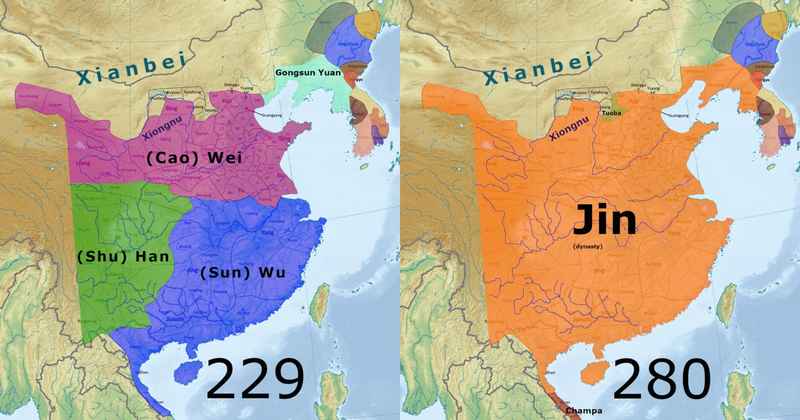
Left: map of three kingdoms in 229 CE right after Wu's establishment.
Right: map in 263 CE right after Wu's end and the beginning of unified Jin.
The Kingdom of Wu (吴), established by Sun Quan (孙权), thrived in the southeastern region of China, with its power base centered around present-day Jiangsu (江苏) and Zhejiang (浙江) provinces.
Sun Quan was a resourceful and diplomatic leader, skillfully forming alliances and leveraging external support to counter the military might of Cao Wei.
The Wu Kingdom enjoyed significant naval strength and used its control over the Yangtze River (长江) to its advantage. They engaged in both land and naval campaigns, expanding their influence and territories. Wu's generals, including the likes of Zhou Yu (周瑜) and Lü Meng (吕蒙), played crucial roles in their military successes.
The Rise
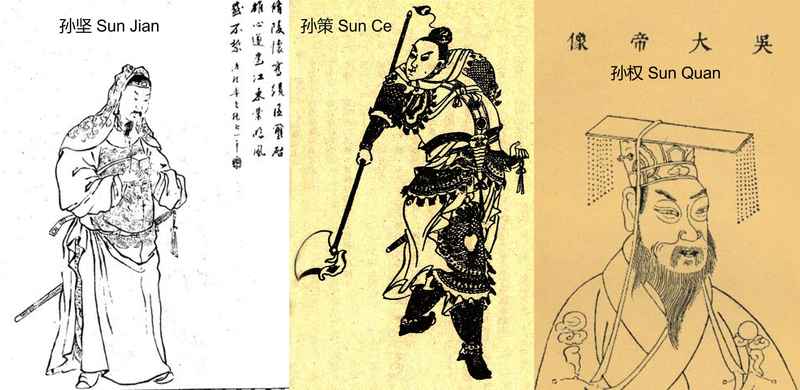
Portratis of Sun Jian, Sun Ce, and Sun Quan
During the late Eastern Han period, Sun Jian (孙坚) participated in suppressing the Yellow Turban Rebellion and later allied with Yuan Shu (袁术) during the chaos caused by Dong Zhuo (董卓), achieving significant military accomplishments.
After Sun Jian's death, his eldest son, Sun Ce (孙策), sought refuge with Yuan Shu in 194 CE. In 197 CE, after Yuan Shu declared himself emperor (though not recognized by others), Sun Ce refused to support him and instead formed an alliance with Cao Cao.
In 199 CE, following Yuan Shu's death, Sun Ce launched campaigns to conquer his territories, absorbing the remnants of Yuan Shu's forces and rapidly growing in strength.
In 200 CE, Sun Ce passed away, and his younger brother, Sun Quan (孙权), assumed leadership of Sun Ce's former troops, with the support of figures such as Zhang Zhao (张昭), Zhou Yu, Cheng Pu (程普), and Lü Fan (吕范).
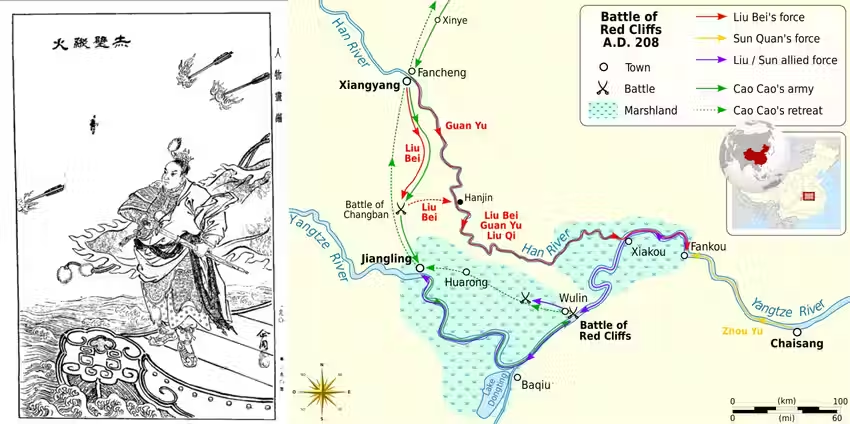
Left: an illustration of Zhou Yu's fire attack at Red Cliffs. Right: The Battle of Red Cliffs.
Between 203 and 208 CE, Sun Quan gradually expanded his sphere of influence and suppressed rebellions.
In 208 CE, after Liu Biao's (刘表) death, Cao Cao who had unified the north, led his troops south, defeating Liu Bei, who was aligned with Liu Biao at the time, and occupying Jingzhou (荆州).
With the assistance of Liu Bei's strategist, Zhuge Liang, Sun Quan decided to form an alliance with Liu Bei to counter Cao Cao. This alliance achieved a victory in the Battle of Red Cliffs, which laid the foundation for the tripartite division of the Three Kingdoms.
However, disagreements between Sun Quan and Liu Bei arose over the control of Jingzhou.
In 219 CE, Sun Quan's forces captured and executed Liu Bei's general, Guan Yu (关羽), and Sun Quan gained control of Jingzhou. Three Gorges (三峡) became a dividing line, with Sun Quan's forces facing off against Liu Bei's, limiting the latter's expansion from the Gorges.
The Establishment and Reign
In 222 CE, Sun Quan was granted the title of King of Wu (吴王) by Cao Pi, the Emperor of Wei (魏).
In 229 CE, Sun Quan declared himself emperor in Wuchang (武昌, present-day Ezhou, 鄂州), later moving the capital to Jianye (建业, present-day Nanjing, 南京). The state was known as Wu or Sun Wu (吴/孙吴) and was also referred to as Eastern Wu (东吴) in history.
Sun Quan's administration focused on fostering cultural and economic development. During its reign, Wu became a center for trade, and its rulers patronized artists, scholars, and intellectuals, leading to a flourishing cultural renaissance.
At its height, the territory of Wu included most of Yangzhou (扬州) and Jingzhou from the end of the Han Dynasty, as well as the entire territory of Jiaozhou (交州). Wu made significant contributions to the development and economic growth of the Jiangnan (江南) region.
However, after Sun Quan's death, Wu gradually declined.
In 280 CE, it was eventually conquered by the Western Jin Dynasty (西晋), marking the complete end of the fragmented situation that existed since the end of Eastern Han in China.
Legacy
The Three Kingdoms Period in China, spanning from 220 to 280 CE, was a legendary time period in Chinese history characterized by intense power struggles, military campaigns, and a rich cultural legacy.
The era produced a pantheon of legendary figures who have become iconic in Chinese folklore.
Cao Cao (曹操) rose to prominence as a shrewd strategist and military leader. Sima Yi (司马懿), a brilliant statesman, military strategist, and power minister, played an important role in shaping Wei's fortunes as well as laying the foundations for the Western Jin Dynasty.
Liu Bei (刘备), known for his virtuous character, was joined by notable figures such as Guan Yu (关羽), the epitome of loyalty and martial prowess, and Zhuge Liang (诸葛亮), the brilliant strategist and advisor, earned the name of the "Sleeping Dragon" (卧龙) for his tactical genius. Other notable heroes include Zhang Fei (张飞), celebrated for his bravery, and Zhao Yun (赵云), renowned for his unwavering loyalty and combat skills.
Sun Quan (孙权) led Wu thrived in the southeastern region, with famous figures including Zhou Yu (周瑜), a brilliant military strategist and general who was known for his literary and martial talents, and Lü Meng (吕蒙), a man of both wisdom and courage with unwavering loyalty.
The Three Kingdoms Period witnessed several famous battles that have become legendary in Chinese history.
The Battle of Guandu (官渡之战) showcased the military brilliance of Cao Cao as he defeated Yuan Shao (袁绍) through strategic maneuvering.
The Battle of Red Cliffs (赤壁之战), a pivotal naval engagement, saw the allied forces of Liu Bei and Sun Quan successfully repel the mighty fleet of Cao Cao using fire-tactics.
Finally, the Battle of Yiling (夷陵之战), a pivotal conflict between the Shu and Wu resulted in Wu's victory, followed by Liu Bei's death not long after, marking a turning point in the fortunes of Shu.
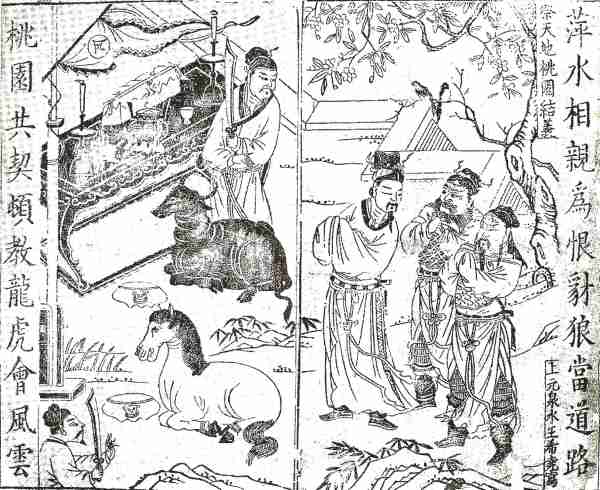
An illustration of the Taoyuan Trio (Liu Bei, Guan Yu and Zhang Fei) from Romance of the Three Kingdoms
Literature played a significant role in immortalizing the Three Kingdoms Period.
Records of the Three Kingdoms (《三国志》) by Chen Shou (陈寿) written in Western Jin serves as the official historical record, offering detailed accounts of political events, military campaigns, and biographies of key figures.
However, it is the epic novel Romance of the Three Kingdoms (《三国演义》) by Luo Guanzhong (罗贯中) written in the late Yuan and early Ming Dynasty has had a lasting impact, romanticizing the era and portraying the heroic exploits and complex relationships of characters such as Liu Bei, Cao Cao, and Sun Quan, which has become one of the Four Great Classical Novels of China (中国四大名著).